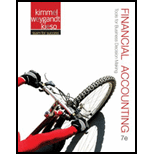
(a)
Statement of
Statement of cash flow is a financial statement that shows the cash and cash equivalents of a company for a particular period of time. It shows the net changes in cash, by reporting the sources and uses of cash as a result of operating, investing, and financing activities of a company.
Cash flows from operating activities: These refer to the cash received or cash paid in day-to-day operating activities of a company.
Direct method: This method uses the basis of cash for preparing the cash flows of statement.
Cash flows from operating activities: In this direct method, cash flow from operating activities is computed by using all cash receipts and cash payments during the year.
- A. Cash Receipts: It encompasses all the cash receipts from sale of goods and on account receivable.
- B. Cash Payments: It encompasses all the cash payments that are made to suppliers of goods and all expenses that are paid.
Cash flow from investing activities: This section of cash flows statement provides information concerning about the purchase and sale of capital assets by the company.
- Deduct the amount of cash used to purchase any fixed assets.
- Add the amount of cash received from sale of any fixed asset.
Cash flow from financing activities: This section of cash flows statement provides information about the
- Add the amount of cash received from any sources of finance.
- Deduct the amount of cash used for payment for dividend and interest from financing activities.
- Deduct the amount of cash used for payment of
treasury stock from financing activities.
Current cash debt coverage ratio:
It is a
Cash debt coverage ratio:
It is a solvency ratio which defines the relationship between operating cash flow to its total liabilities. This ratio would be helpful in indicating the ability of the business to pay off the total liabilities from the total business operations.
To Prepare: Statement of cash flows of K Company using direct method.
(b)
(1)
To compute: the current cash debt coverage ratio.
Want to see the full answer?
Check out a sample textbook solution
Chapter 12 Solutions
Financial Accounting
- helparrow_forwardBudgeted overhead for Galaxy Manufacturing at the normal capacity of 40,000 direct labor hours is $7 per hour variable and $5 per hour fixed. In April, $460,000 of overhead was incurred while working 41,500 actual hours, when 42,000 standard hours were allowed. What is the overhead controllable variance?arrow_forwardDesert Rose Electronics implemented a new returns authorization process. Returns require: inspection code (45% weighting), testing report (35% weighting), customer details (20% weighting). If a return scored 38 on inspection, 42 on testing, and 85 on customer details, your task is to identify the weighted acceptance score. Need answerarrow_forward

 AccountingAccountingISBN:9781337272094Author:WARREN, Carl S., Reeve, James M., Duchac, Jonathan E.Publisher:Cengage Learning,
AccountingAccountingISBN:9781337272094Author:WARREN, Carl S., Reeve, James M., Duchac, Jonathan E.Publisher:Cengage Learning, Accounting Information SystemsAccountingISBN:9781337619202Author:Hall, James A.Publisher:Cengage Learning,
Accounting Information SystemsAccountingISBN:9781337619202Author:Hall, James A.Publisher:Cengage Learning, Horngren's Cost Accounting: A Managerial Emphasis...AccountingISBN:9780134475585Author:Srikant M. Datar, Madhav V. RajanPublisher:PEARSON
Horngren's Cost Accounting: A Managerial Emphasis...AccountingISBN:9780134475585Author:Srikant M. Datar, Madhav V. RajanPublisher:PEARSON Intermediate AccountingAccountingISBN:9781259722660Author:J. David Spiceland, Mark W. Nelson, Wayne M ThomasPublisher:McGraw-Hill Education
Intermediate AccountingAccountingISBN:9781259722660Author:J. David Spiceland, Mark W. Nelson, Wayne M ThomasPublisher:McGraw-Hill Education Financial and Managerial AccountingAccountingISBN:9781259726705Author:John J Wild, Ken W. Shaw, Barbara Chiappetta Fundamental Accounting PrinciplesPublisher:McGraw-Hill Education
Financial and Managerial AccountingAccountingISBN:9781259726705Author:John J Wild, Ken W. Shaw, Barbara Chiappetta Fundamental Accounting PrinciplesPublisher:McGraw-Hill Education





